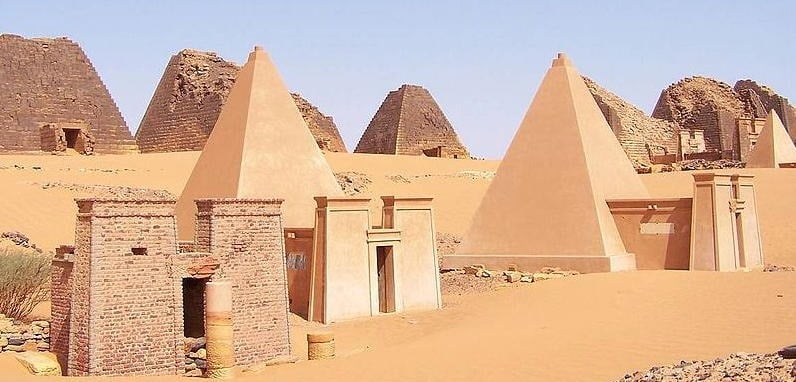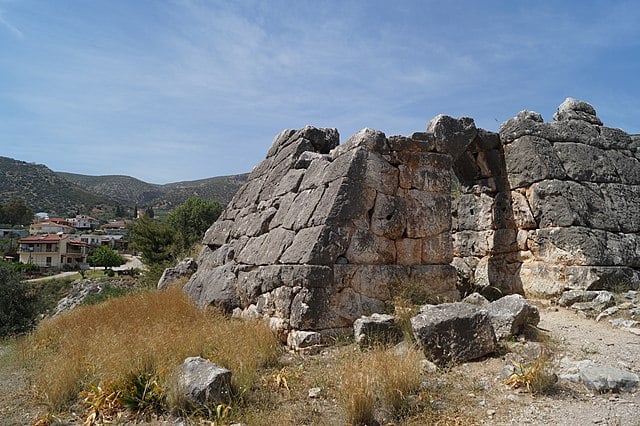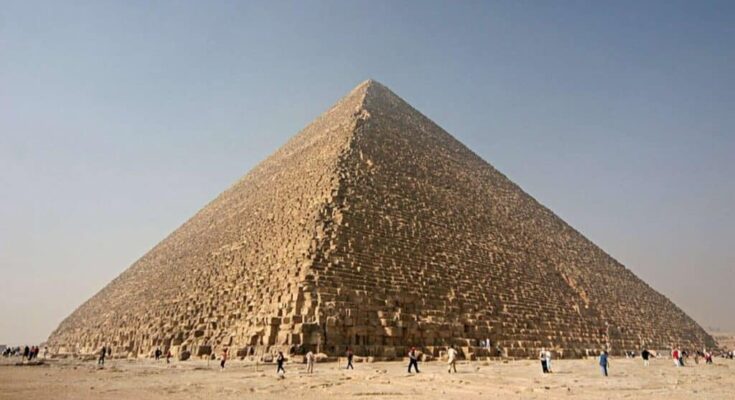
Pyramids are geometric, pyramid-shaped structures found around the world and utilized by various civilizations primarily for religious or ceremonial purposes. While the Egyptian pyramids are those that are most well known, they are not the only ones.
Architecture of the world’s pyramids
Pyramids are geometric constructions in which all the outer surfaces (except the base) are triangular, converging to a common point. The base of a pyramid can be triangular, quadrilateral, or polygonal, requiring at least three triangular sides. A common form is the square pyramid, with a square base and triangular sides.
The pyramid’s design—with its center of gravity close to the ground and converging sides at the top—minimizes the need to lift materials to great heights. This distribution of mass enabled early cultures to build stable, monumental structures.
Egyptian pyramids
The Egyptian pyramids are ancient, pyramid-shaped structures located in Egypt. As of November 2008, sources list 118 to 138 confirmed Egyptian pyramids. The Egyptians built these as tombs for pharaohs and their wives during the Old and Middle Kingdoms.
The most ancient Egyptian pyramid is the Great Pyramid of Giza (also known as the Pyramid of Cheops). It is the oldest and largest of the three pyramids in the Giza Necropolis and borders the modern city of Giza.
The pyramid is believed to have been built as a tomb for the Fourth Dynasty pharaoh Cheops over a period of twenty years. It is the oldest of the Seven Wonders of the Ancient World and the only one that survives to this day. The pyramid is a UNESCO World Heritage Site.
Some believe that Cheops’ vizier, Hemiunu, was the architect of the Great Pyramid. Originally standing at a height of 146.5 meters, the pyramid today measures 138.8 meters. This is due to erosion and the absence of its capstone. Each side was just over 230 meters in length. According to Levy, archeologists estimate the pyramid’s mass at 5.9 million tons, with a volume of approximately 2.5 million cubic meters. The pyramid held the record as the tallest building in the world for 3,800 years until the spire of Lincoln Cathedral in Lincoln, England was completed.
Egyptians built the first pyramids around the years 2700 BC to 1700 BC. During the Third Dynasty, the Pharaoh Djoser and his architect Imhotep erected the first pyramid. The Egyptians believed that the pharaoh would join with the sun during descent. This is why they placed pyramids west of the Nile River, so that his soul would unite with it.

Pyramids of Sudan
Even though people usually associate pyramids with Egypt, Sudan’s Nubian pyramids number nearly 240—the most in the world. The ancient Kushite kingdoms that existed south of Egypt in Nubia (modern-day Sudan) built the Nubian pyramids during the 2nd and 1st millennia BC. The first of these was built in the El Kurru area, along with the tombs of King Kashta and King Piankhi.
The pyramids in the areas of El Kurru and Nuri are the oldest and largest, while the Meroë pyramid complex is the largest by area. It is located between the 5th and 6th cataracts of the Nile, about 62 miles (100km) from Khartoum. During the Meroitic period, around 40 kings and queens were buried there. Other pyramids are located in the Jebel Barkal area.
Nubian pyramids differ from their Egyptian counterparts. The Nubians built them in steps with horizontally placed stones. They range in height from 20 to 99 feet (6 to 30 meters).
Ancient looters ransacked all the pyramids, and they damaged or destroyed many of them in the 19th century. Reliefs inside reveal that the kings were mummified, and gold and other treasures were placed with them in their burial chambers.

Greek pyramids
Pausanias mentions two pyramids in Argos that served as burial places for soldiers. However, neither of these have survived.
When world audiences consider ancient Greece, pyramids don’t often come to mind. This is partially due to the fact most usually associate pyramids with ancient Egypt. There is controversy as to whether the Hellinikon pyramid can actually be considered a pyramid at all, and its date and purpose have been disputed.
In 1991, physics Professor Ioannis Lirintzis and archeologist Adamantios Sampson, along with their team, devised a new method of analysis known as thermoluminescence dating. Liritzis’ specialty is the application of natural sciences to archaeology and cultural heritage. The results of their study contradicted scientists’ previous beliefs, placing the pyramid’s construction at around 3000 BC.
Mary Lefkowitz, the prominent professor of classics, objected to the Liritzis/Sampson research findings. She argued that they simply recycled the rocks that they used for the construction of the pyramid from buildings of a previous era. She also claimed that Greek archeologists ignored research done in 1930 confirmed by archeologist Helena Fracchia in 1980.
In response, Liritzis and company declared that Lefkowitz simply did not understand the science of their dating methods.
The ancient “pyramids” in Greece consist of Ligourio in Epidaurus, Kambia in Nea Epidaurus, Amfio near Thebes, Sikyon in Corinthia, Dalamanara in Epidaurus, Viglafia in Neapoli, and the Hellenikon Pyramid in Hellenikon.
While the ancient Greek pyramid Hellinikon is supposedly the most well-preserved one, Kambia has also been quite well preserved to some extent. Only the foundations of the pyramids at Ligourio and Viglafia presently exist, and there are, at present, even fewer fragments of the structures at Sikyon and Dalamanara.

The world’s Mesopotamian pyramids
The Mesopotamians built the earliest pyramidal structures, known as ziggurats. Various Mesopotamian civilizations constructed these massive, stepped pyramids with the main temple positioned at the top.
Notable examples include the Great Ziggurat of Ur near Nasiriyah, the Ziggurat of Akar Kuf, the ruined Etemenanki in Babylon (possibly the inspiration for the biblical Tower of Babel), and Chonga Zanbil in Iran.
It is widely accepted that Sumerian city-states evolved around central temples, or ziggurats, which served as centers of economic, cultural, religious, and social life. Sumerian cities had roads, buildings, and houses made of clay or bricks, and these were organized in a labyrinthine layout.
Sumerians, as well as Babylonians, Elamites, Akkadians, and Assyrians, built ziggurats, and each one was part of a temple complex that included various other structures.
The earliest Mesopotamian ziggurats emerged in the Early Dynastic Period, with the first Anu Ziggurat dating to around 4000 BC. According to Herodotus, these structures featured shrines at the top.

Tomb of Askia—Mali
Askia Muhammad I, emperor of Mali’s Songhai Empire, constructed the remarkable pyramidal structure known as the Tomb of Askia in the late 15th century, funded through the empire’s control of trans-Saharan trade, particularly in salt and gold.
Located in the city of Gao, the Tomb of Askia complex includes the pyramidal tower. It also includes two flat-roofed mosques, necropolises, and the White Stone Square. Askia Muhammad I built the tomb in 1495, when Gao became the empire’s capital and Islam prevailed as the official religion, exemplifying the Sudano-Sahelian architectural style.
Regular renewal of plaster creates the style’s rounded forms, as rare but intense rains erode it each winter. The tomb’s pyramidal shape, its function as a central minaret, and the distinctive design and arrangement of the wooden beams used for permanent scaffolding give the Tomb of Askia its unique architectural features.
Mesoamerican pyramids—among the world’s greatest
The pyramids of Central America are among the most famous architectural remnants of the great civilizations that once thrived in the region, namely the Mayans and Aztecs. These structures served various purposes. They were sometimes used as burial monuments, while at other times they were utilized as temple platforms. Occasionally, they served as mountain effigies of sacred places.
Two of the most significant pyramids, the Pyramid of the Sun and the Pyramid of the Moon, are located in the ancient city of Teotihuacán in Mexico. The Pyramid of the Sun was named by the Aztecs who visited the Mexican city, but its original name remains unknown. The Aztecs constructed the pyramid in two phases.
The first phase took place around 200 AD, during which the pyramid was built to its current height. In the second phase, it was completed to its final dimensions—225 meters in length and 75 meters in height. This makes it the third-tallest pyramid in the world, slightly shorter than the Pyramid of Cheops (230 meters), though it is also much smaller than the Pyramid of Cholula (450 meters). The Aztecs also built an altar at the top during the second phase, but that has not been preserved.
According to Doris Heyden, the Aztecs probably dedicated the pyramid to a deity that the people of Teotihuacán worshiped. However, the destruction of the temple at its peak has thus far prevented scholars from linking it to a specific deity.




